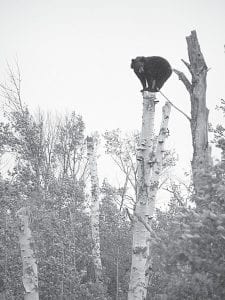Minnesota Department of Natural Resources (DNR) wildlife managers have reported an increase in nuisance bear complaints in recent weeks. “This is a tough time of year for bears,” said Mark Spoden, DNR assistant area wildlife manager in Grand Rapids. “After hibernation, they are hungry. When berries and vegetation are scarce, bears are often tempted by dog food, livestock feed, birdseed, barbecues, compost or garbage.”
In addition, female bears are chasing away last year’s offspring. These young bears are inexperienced at finding food and searching for territories of their own. They are the most likely to show up in places where they aren’t welcome.
There have been a number of calls to local DNR conservation officers. In a recent conservation officer report, CO Darin Fagerman reminded residents who live close to bear habitat to check their property for food sources that could attract bears. When human-related food is easy to find, bears stop seeking their natural foods. Research and experience show that removing the food that attracts bears resolves bear problems much more effectively than attempting to trap and destroy the bear. “Be fair to the bears,” wrote Fagerman.
Although the DNR does not recommend it, many North Shore residents have had luck chasing bears off by clanging pots and pans or firing a gunshot into the air. Tory Wentland on North Road in
Hovland said a small bear hanging around her yard finally left when she serenaded him with squeaks from her oboe. Other county residents have had success chasing bears away by shooting firearms into the air. “If a bear enters your yard, don’t panic and don’t approach the bear,” said Spoden. “Always leave the bear an escape route. Everyone should leave the area and go inside until the bear leaves. A treed bear should be left alone as well. It will leave once the area is quiet.” Bears are normally shy and usually flee when encountered, but they may defend an area if
” they are feeding or are with their young. Spoden said they are unpredictable wild animals. Although they rarely injure people, they are potentially dangerous because of their size, strength and speed.



Loading Comments